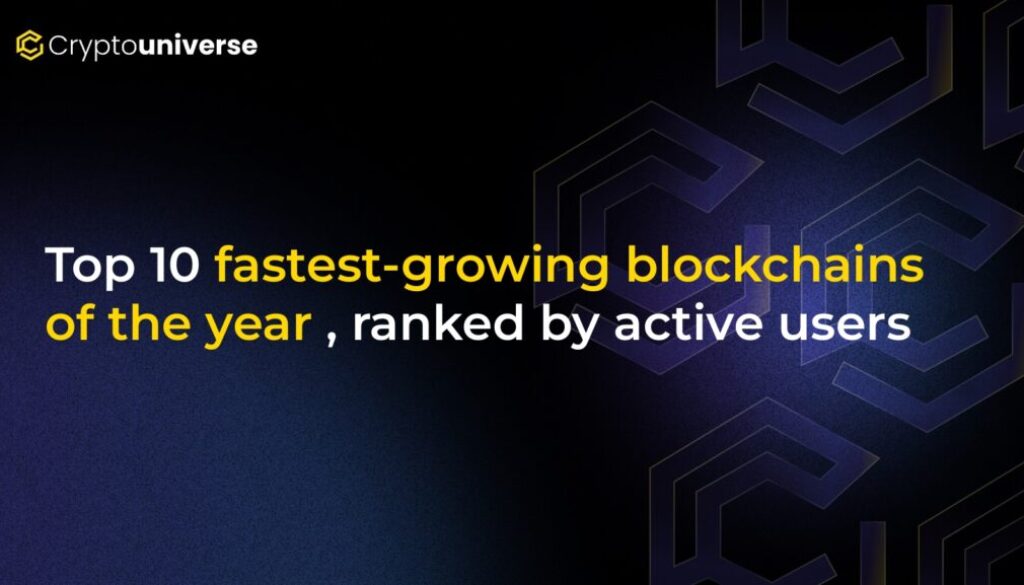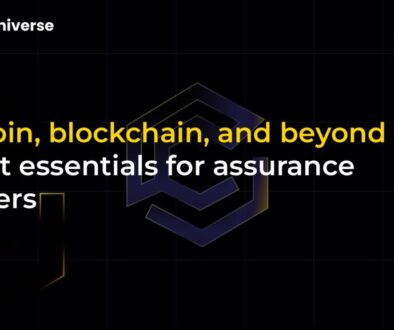Top 10 fastest-growing blockchains of the year, ranked by active users

Beyond the Hype: Ranking Blockchains by Real-World Usage
The blockchain landscape in 2025 is a far cry from the speculative frenzy of years past. Today, the measure of a network’s success isn’t just token price or social media hype; it’s about real, tangible user engagement. As the industry matures, the key metric that separates the contenders from the pretenders is the number of active users—actual people and entities interacting with the technology.
From high-speed Layer-1s built for decentralized finance (DeFi) to nimble Layer-2s making crypto accessible for everyone, a new generation of blockchains is attracting millions of users. This growth is fueled by low-cost transactions, thriving app ecosystems, and seamless integrations with mainstream platforms.
This article dives deep into the data to rank the top 10
Understanding the Terminology
Before we jump in, let’s clarify a few key terms:
- Active Users: A unique wallet address that has completed at least one transaction on the network within a specific period (in our case, monthly).
- Layer-1 (L1): The foundational blockchain, like Bitcoin or Ethereum, which validates and finalizes transactions on its own network.
- Layer-2 (L2): A network built on top of an L1 to improve scalability and reduce costs. Polygon and Arbitrum are prime examples that operate on top of Ethereum.
The Top 10 Fastest-Growing Blockchains of 2025
1. Solana (SOL)
Type: Layer-1
Monthly Active Users: 57 million
Key Growth Drivers:
- High-Speed DeFi and Memecoins: Solana’s incredible transaction speed, powered by its unique Proof-of-History (PoH) consensus, has made it the go-to chain for high-frequency trading, particularly within the memecoin and DeFi sectors.
- Technical Upgrades: The rollout of the Firedancer validator client has significantly improved network reliability, addressing past concerns about outages.
- Institutional Interest: A growing number of institutions are adopting Solana for its performance, further cementing its position as a top contender.
Challenges:
- Centralization Concerns: Critics point to its validator hardware requirements as a potential point of centralization.
- Intense Competition: Faces stiff competition from both established L1s and emerging Ethereum L2 solutions.
2. Near Protocol (NEAR)
Type: Layer-1
Monthly Active Users: 51.2 million
Key Growth Drivers:
- AI Integration: Near is carving a unique niche by focusing on AI-native features, enabling user-owned AI agents and decentralized applications.
- User-Friendly and Sustainable: With its carbon-neutral status and consistently low transaction fees, Near appeals to both developers and environmentally conscious users.
- Strategic Partnerships: Collaborations with projects like EigenLayer are enhancing its technical capabilities and expanding its ecosystem.
Challenges:
- Market Volatility: Despite strong user growth, its native token price can be volatile.
- Sharding Complexity: While its sharding architecture boosts scalability, it can also introduce potential technical vulnerabilities.
3. BNB Chain (BNB)
Type: Layer-1
Monthly Active Users: 46.4 million
Key Growth Drivers:
- Performance Boosts: Recent upgrades have reduced block times to just 0.75 seconds, enhancing the user experience for its vast DeFi and gaming ecosystem.
- AI-Powered Features: Like Near, BNB Chain is integrating AI to enhance data ownership and application capabilities.
- Binance Ecosystem: Its deep integration with the world’s largest crypto exchange provides a massive built-in user base and liquidity.
Challenges:
- Centralization Risk: Its close ties to Binance raise ongoing concerns about centralization and censorship resistance.
- Regulatory Scrutiny: The chain and its backers face continuous regulatory pressure globally.
4. Base
Type: Layer-2 (Ethereum)
Monthly Active Users: 21.5 million
Key Growth Drivers:
- Coinbase Onboarding: Developed by Coinbase, Base has a direct funnel to the exchange’s 100+ million users, simplifying the onboarding process into Web3.
- Ultra-Low Fees: With average transaction fees around $0.01, Base makes DeFi and consumer DApps accessible to a broader audience.
- Thriving App Ecosystem: A surge in stablecoin flows and innovative consumer apps has quickly turned Base into a hub of activity.
Challenges:
- Congestion Issues: Its popularity has led to periods of network congestion.
- Security Dependence: As an L2, its security is ultimately reliant on the Ethereum mainnet.
5. Tron (TRX)
Type: Layer-1
Monthly Active Users: 14.4 million
Key Growth Drivers:
- Stablecoin Dominance: Tron has become a dominant platform for low-cost stablecoin transactions, particularly USDT, making it popular for payments and transfers in emerging markets.
- Platform Integrations: Strong ties with platforms like Telegram and Rumble Cloud expand its reach into content sharing and cloud services.
- Negligible Fees: Consistently low fees make it an attractive alternative for high-volume, low-value transactions.
Challenges:
- Regulatory Headwinds: The network and its founder face significant regulatory scrutiny in various jurisdictions.
- Centralization Questions: Similar to BNB Chain, concerns about its degree of decentralization persist.
6. Bitcoin (BTC)
Type: Layer-1
Monthly Active Users: 10.8 million
Key Growth Drivers:
- Institutional Inflows: The approval of spot Bitcoin ETFs has unlocked a torrent of institutional capital, with professional investors holding billions in BTC-backed products.
- Digital Gold Narrative: The Bitcoin halving event reduces new supply, reinforcing its narrative as a store-of-value and a hedge against inflation.
- Layer-2 Innovation: The rise of Bitcoin L2s is beginning to expand its utility beyond simple payments.
Challenges:
- Energy Consumption: Its Proof-of-Work consensus mechanism remains a subject of environmental debate.
- Macroeconomic Sensitivity: As a macro asset, Bitcoin’s price is highly sensitive to global economic factors like interest rates.
7. Aptos (APT)
Type: Layer-1
Monthly Active Users: 10 million
Key Growth Drivers:
- Advanced Technology: Built by ex-Meta engineers using the secure Move programming language, Aptos is designed for high performance and reliability.
- High Throughput: The network boasts a peak throughput of over 19,000 transactions per second (TPS), making it highly scalable.
- Ecosystem Expansion: Key partnerships, including the native launch of Tether (USDT), are attracting more users and liquidity.
Challenges:
- Adoption Hurdles: As a newer blockchain, it needs to build a broader user base to compete with established giants.
- Crowded L1 Market: It faces intense competition from other high-performance L1s like Solana.
8. Ethereum (ETH)
Type: Layer-1
Monthly Active Users: 9.6 million
Key Growth Drivers:
- The Pectra Upgrade: Upcoming upgrades promise to improve user experience and scalability, keeping the network competitive.
- Institutional Staking and ETFs: The potential for Ether ETFs and growing institutional staking are major catalysts for adoption.
- Unmatched Ecosystem: Ethereum remains the undisputed leader for DeFi, NFTs, and developer activity, with the largest and most battle-tested ecosystem.
Challenges:
- High Gas Fees: Despite improvements, transaction fees on the mainnet remain higher than its rivals, pushing users to L2s.
- Scalability Bottlenecks: The network still faces scalability challenges, which L2s are working to solve.
9. Polygon (MATIC)
Type: Layer-2 (Ethereum)
Monthly Active Users: 7.2 million
Key Growth Drivers:
- Enterprise Adoption: Polygon has successfully onboarded numerous Fortune 500 companies, including Starbucks and Microsoft, for Web3 initiatives.
- Multi-Chain Vision: Upgrades are enhancing interoperability, positioning Polygon as a central scaling hub for a multi-chain future.
- EVM Compatibility: Its compatibility with the Ethereum Virtual Machine (EVM) makes it easy for developers to migrate their DApps.
Challenges:
- Regulatory Landscape: Faces uncertainty under new frameworks like Europe’s MiCA regulation.
- Fierce L2 Competition: The L2 space is becoming increasingly crowded with rivals like Arbitrum, Optimism, and Base.
10. Arbitrum One (ARB)
Type: Layer-2 (Ethereum)
Monthly Active Users: 4 million
Key Growth Drivers:
- DeFi Powerhouse: Arbitrum is home to some of the most innovative and widely used DeFi protocols, attracting significant liquidity and trading volume.
- Mainstream Integrations: Partnerships with platforms like Robinhood for tokenized assets are bridging the gap between traditional finance and DeFi.
- Technical Innovation: The Stylus upgrade allows developers to build DApps using multiple programming languages, lowering the barrier to entry.
Challenges:
- Dependence on Ethereum: Like all L2s, its performance and security are tied to the Ethereum mainnet.
- Competition with Optimism: Engaged in a tight race with its main rival, Optimism, for L2 market share.
What’s Fueling This Explosive Growth?
The rise of these top blockchains isn’t happening in a vacuum. Several key trends are converging to drive user adoption across the industry:
- The Rise of Layer-2s: Scaling solutions like Base and Arbitrum are making Ethereum usable for everyday activities by drastically lowering fees, making DApps more affordable and accessible.
- Stablecoins as a Gateway: Stablecoins like USDT and USDC are the lifeblood of DeFi, increasing transaction volumes and providing a stable medium of exchange that attracts new users.
- DeFi and NFT Innovation: Cutting-edge financial protocols and vibrant digital collectible marketplaces continue to be powerful magnets for user engagement.
- Mainstream and Institutional Adoption: The entry of institutional capital through Bitcoin ETFs and partnerships with major corporations like Coinbase and Starbucks are lending unprecedented legitimacy and liquidity to the space.
Conclusion: A New Era of Blockchain Adoption
The story of blockchain in 2025 is one of rapid acceleration and a fundamental shift toward utility. Networks like Solana, Near, and Base are not just growing—they are building vibrant ecosystems that solve real problems and offer compelling user experiences. By focusing on active users, we get a clearer picture of who is winning the race for adoption.
However, challenges remain. Inflated metrics from bot activity, the constant trade-off between scalability and decentralization, and an uncertain regulatory environment are all hurdles the industry must overcome. The blockchains that succeed will be those that continue to innovate, build strong communities, and prove their value in the real world.


